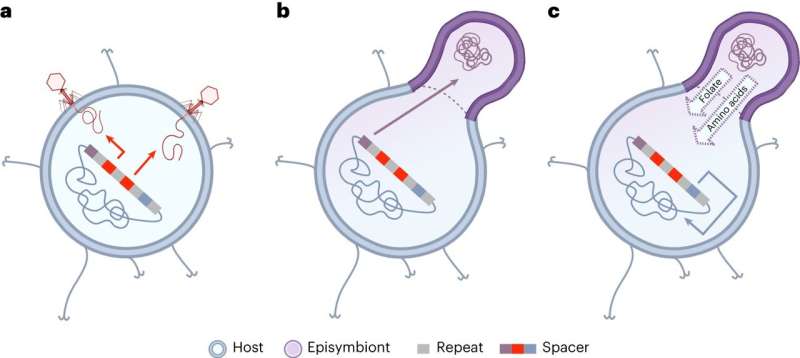This article has been reviewed according to Science X's editorial process and policies. Editors have highlighted the following attributes while ensuring the content's credibility:
fact-checked
peer-reviewed publication
proofread
Microorganisms ward off parasites: Potential new function of CRISPR-Cas system discovered

Microorganisms use the CRISPR-Cas system to fight viral attacks. In genetic engineering, the microbial immune system is used for the targeted modification of the genetic make-up. A research team has now discovered another function of this specialized genomic sequence: archaea—microorganisms that are often very similar to bacteria in appearance—also use them to fight parasites. The team, under the leadership of Professor Dr. Alexander Probst, microbiologist at the Research Center One Health Ruhr at the University of Duisburg-Essen (UDE), has now published its findings in Nature Microbiology.
Biochemists Emmanuelle Charpentier and Jennifer Doudna received the Nobel Prize for the biotechnological application of the CRISPR-Cas systems, or "genetic scissors," for genetic engineering in 2020. However, many functions of this genetic tool are still unexplored to date. Could microorganisms, for example, use them to fight off other microorganisms that live on them as parasites?
With this research question in mind, Probst analyzed the genetic material of microbes in the Earth's deep crust. "More than 70% of the Earth's microorganisms are housed in the deep biosphere. If we want to understand diversity on our planet, it is worth taking a look into the deep," he explains.
With his team, the microbiologist has analyzed the water that a geyser in the U.S. spits to the surface from the depths, as well as samples from the Horonobe underground laboratory in Japan. The research team focused on archaea, which live in the ecosystem as hosts and parasites. The tiny microbes are highly similar to bacteria in cell size but have substantially different physiological properties.
The result of their genomic analysis provided new insights: there were conspicuously few parasites in the vicinity of the hosts, and the hosts showed genetic resistance to the parasites. The researchers discovered the reason for this in the genetic scissors in the genome of the microorganisms.
"In the course of evolution, the archaea have incorporated the parasitic DNA. If a parasite with the same DNA now attacks the organism, the foreign genetic material is probably recognized by the CRISPR system and presumably decomposed," Probst explains. The microbiologist is an expert in the analysis of genetic material from environmental samples and uses the latest methods in his lab, such as Oxford Nanopore technology, which enables rapid and comprehensive sequencing of the material.
In order to rule out the possibility that they have only come across isolated cases, the researchers have extended the analysis to more than 7,000 genomes and observed the phenomenon very frequently. In future research, this finding will also facilitate distinguishing between beneficial symbionts and harmful parasites. If there has been a CRIPSR recognition, the microorganism is very likely to be a parasite. This knowledge can also help us better understand important metabolic processes, such as the carbon flow in ecosystems, in the future.
More information: Sarah P. Esser et al, A predicted CRISPR-mediated symbiosis between uncultivated archaea, Nature Microbiology (2023). DOI: 10.1038/s41564-023-01439-2
Journal information: Nature Microbiology
Provided by Universität Duisburg-Essen




















